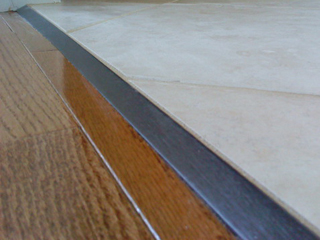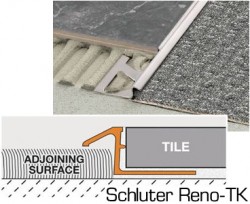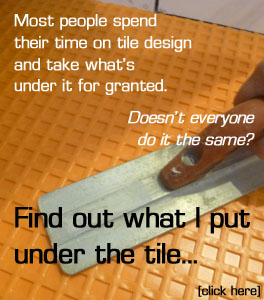What are some of your options when making the transition from tile to laminate flooring? That’s what Murray C. wanted to know. He writes…
“Peter, we are finishing our basement with laminate and ceramic tile. The transition from tile to laminate is causing us some concern as we don’t have much experience. The schluter type metal transition is very interesting and I noted your article on this. [This post] Should the vertical part of the strip be the same thickness as the tile and should this dimension include the small lip at the top of the strip? Will the strip adhere directly underneath the tile or does it have to be buried in the thin set? You mentioned grouting the hollow area. Does this have to be done as you are laying the tile or do you wait and slowly work in the grout using a float? Thanks in advance for you help.”
 When considering a transition between two types of flooring. My first question is, “What will the height differences be between the two finished surfaces?”
When considering a transition between two types of flooring. My first question is, “What will the height differences be between the two finished surfaces?”
In Murray’s example, I’m going to assume that the entire floor was flat before adding tile and laminate. Ceramic floor tile is typically 3/8″ thick + 1/8″ or so for thinset making the finished tile surface around 1/2″ high off of the original floor. A typical laminate floor may be around 1/4″- 3/8″ thick. This means that the tile will likely finish out just a little higher than the laminate, probably around 1/8″.
In this case, here are a couple options I would suggest.
OPTION 1- Use a laminate edge trim and the butt the tile up to it. Laminate flooring manufacturers often sell various types of transitions and trims that perfectly match their flooring. Depending on the height difference, you can use a piece of edge trim that has a lip to cover up the edges of your laminate pieces and provide you with a straight edge to tile up to. If you use this method, I wouldn’t grout between the tile and trim, instead you’d want to get caulk (matched to the grout color) that will offer some flexibility along this seam. If the heights are nearly the same, you can use a “T” trim that just covers the gap and makes a nice transition between the two floors.
 BETTER OPTION 2- Murray had mentioned Schluter trim, which I’m a big fan of. (See www.Schluter.com). I pulled out their catalog to see which of their products might be best for our situation. I found one called RENO-TK . It’s meant for transitioning from tile to a lower surface that is 1/4″ high. Often this is carpet, but this may work for laminate. The key is to know your measurements and make sure the trim will fit. Perhaps an even better choice would be RENO-V. It actually has a “movable tranistion arm” to adjust to the height of the adjacent floor. This will provide some flexibility for the height of the laminate floor, which may work well in our example.
BETTER OPTION 2- Murray had mentioned Schluter trim, which I’m a big fan of. (See www.Schluter.com). I pulled out their catalog to see which of their products might be best for our situation. I found one called RENO-TK . It’s meant for transitioning from tile to a lower surface that is 1/4″ high. Often this is carpet, but this may work for laminate. The key is to know your measurements and make sure the trim will fit. Perhaps an even better choice would be RENO-V. It actually has a “movable tranistion arm” to adjust to the height of the adjacent floor. This will provide some flexibility for the height of the laminate floor, which may work well in our example.
When you order a Schluter trim you have to specify the thickness of your tile. The height of the trim will match. In our example, you’d want to make sure the height of the trim was 3/8″. I’ve found that if I match the height of the tile with the height of the trim, it comes out nice. With thinset, the tile may rise above the trim just a little, but that’s better than having the trim stick up where it can be tripped on.
 The Schluter trims mentioned here are set in the thinset and partially covered by the tile. Here are two ways I’ve installed it:
The Schluter trims mentioned here are set in the thinset and partially covered by the tile. Here are two ways I’ve installed it:
1. Spread the thinset over the area. Lay the trim in place, lay the tile in place. (no nails holding the trim, just thinset)
2. When the trim is a tricky installation, I sometimes will nail it in place using a few galvanized roofing nails. Caution: The nails may present a ‘rocking point’ that sticks up too high, even with their flat heads. If this happens, use your wet saw blade to carefully grind off a little of the backside of the tile so that it rests flat on the floor and doesn’t rock anymore. I used this method the other day because I wanted to nail to pieces of trim and make sure the joint stayed together and flush as I was laying the tile.
When you are ready to grout, grout the space between the tile and trim like the rest of the floor. I like to put some painter’s tape on the exposed part of the trim so that I don’t accidentally scratch it, but this also keeps the grout from going any further than it should. I remove the tape after I’ve been over the floor a couple times with my sponge cleaning off grout. This is one of my favorite moments- the unveiling of the finished transition!
Murray C., I hope this helps you with your project. Thanks for asking!










Murray Carlson
September 13, 2010 , 11:03 pm
Peter Bales
September 14, 2010 , 6:02 am
Doug
July 5, 2012 , 6:21 pm